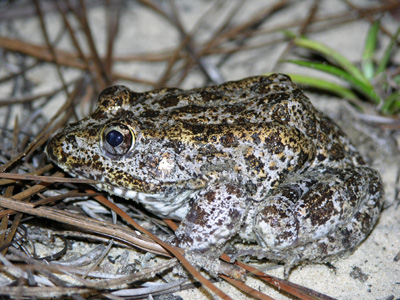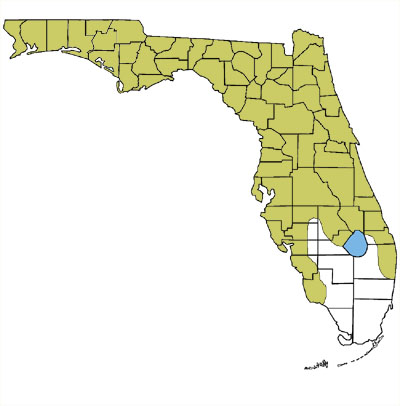Florida's Frogs & Toads
"True" Frogs (Family Ranidae)
_________________________________________________________
Gopher Frog
(Lithobates capito)FLORIDA SPECIES OF SPECIAL CONCERN
Gopher Frog
Photo by Dr. Steve A. Johnson (UF). To obtain permission to use this photo for educational purposes, email tadpole@ufl.edu.
Size:
Usually 2.5 to 3.5 in. (max. 4.25 in.)
Identification:
Body is tan to gray; skin is warty or even wrinkled-looking. Back and belly are marked with irregular brown or black spots. They have a raised ridge down each side of their body. Like all "true frogs," they have large eardrums and webbed hind feet. Head is very wide in comparison to the body.
Breeding:
Year round (but mainly winter); eggs are laid in a single, large cluster (about 2,000 eggs) attached to emergent vegetation. Call is a deep, loud snore. To hear frog calls, visit the USGS Frog Call Lookup and select the species you want to hear from the common name drop-down list.
Diet:
Beetles, crickets, spiders, worms, other small invertebrates, small frogs.
Habitats:
Found throughout northern and central Florida, and in upland areas near the coast of southern Florida, in small mammal or tortoise burrows in sandhills, pine-oak forests, dry hammocks, scrubs, and pine flatwoods, often far from breeding sites. Breeds in shallow, temporary (fish-free) wetlands, including cypress domes and sinkhole ponds. For more information about Gopher Frog ecology, and the importance of fire for maintaining high quality Gopher Frog habitat, read "Gopher Frogs, Burrows, and Fire: Interactions in the Longleaf Pine Ecosystem."
Map by Monica E. McGarrity - may be used freely for education.
Go Back to Florida's Frogs - All Regions


